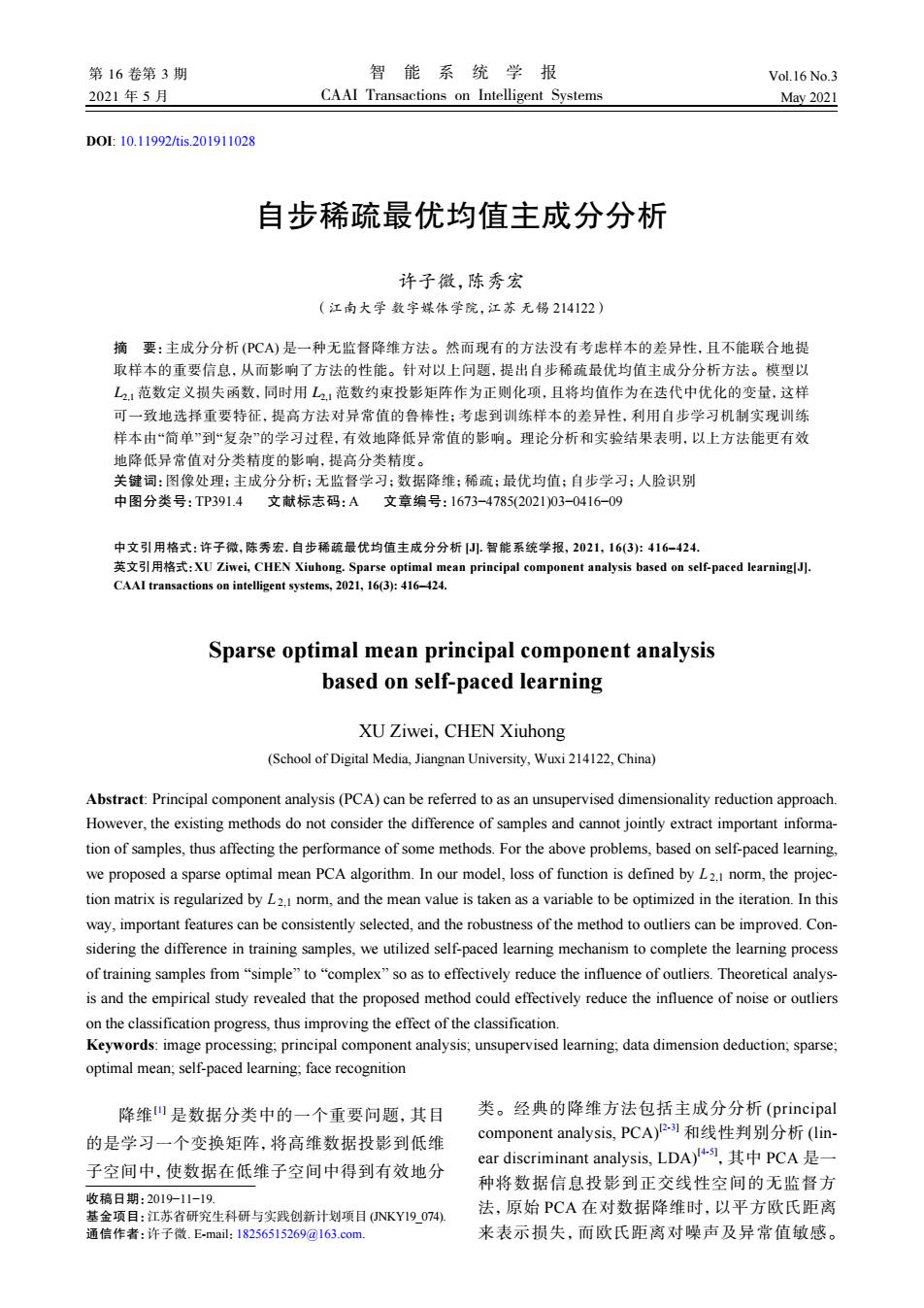正在加载图片...

第16卷第3期 智能系统学报 Vol.16 No.3 2021年5月 CAAI Transactions on Intelligent Systems May 2021 D0:10.11992/tis.201911028 自步稀疏最优均值主成分分析 许子微,陈秀宏 (江南大学数字媒体学院,江苏无锡214122) 摘要:主成分分析(PCA)是一种无监督降维方法。然而现有的方法没有考虑样本的差异性,且不能联合地提 取样本的重要信息,从而影响了方法的性能。针对以上问题,提出自步稀疏最优均值主成分分析方法。模型以 L21范数定义损失函数,同时用L2!范数约束投影矩阵作为正则化项,且将均值作为在迭代中优化的变量,这样 可一致地选择重要特征,提高方法对异常值的鲁棒性:考虑到训练样本的差异性,利用自步学习机制实现训练 样本由“简单”到“复杂”的学习过程,有效地降低异常值的影响。理论分析和实验结果表明,以上方法能更有效 地降低异常值对分类精度的影响,提高分类精度。 关键词:图像处理;主成分分析;无监督学习:数据降维:稀疏:最优均值;自步学习;人脸识别 中图分类号:TP391.4文献标志码:A文章编号:1673-4785(2021)03-0416-09 中文引用格式:许子微,陈秀宏.自步稀疏最优均值主成分分析J.智能系统学报,2021,16(3):416-424. 英文引用格式:XU Ziwei,,CHEN Xiuhong.Sparse optimal mean principal component analysis based on self--paced learning[J]. CAAI transactions on intelligent systems,2021,16(3):416-424. Sparse optimal mean principal component analysis based on self-paced learning XU Ziwei,CHEN Xiuhong (School of Digital Media,Jiangnan University,Wuxi 214122,China) Abstract:Principal component analysis(PCA)can be referred to as an unsupervised dimensionality reduction approach. However,the existing methods do not consider the difference of samples and cannot jointly extract important informa- tion of samples,thus affecting the performance of some methods.For the above problems,based on self-paced learning, we proposed a sparse optimal mean PCA algorithm.In our model,loss of function is defined by L2.I norm,the projec- tion matrix is regularized by L2.I norm,and the mean value is taken as a variable to be optimized in the iteration.In this way,important features can be consistently selected,and the robustness of the method to outliers can be improved.Con- sidering the difference in training samples,we utilized self-paced learning mechanism to complete the learning process of training samples from "simple"to "complex"so as to effectively reduce the influence of outliers.Theoretical analys- is and the empirical study revealed that the proposed method could effectively reduce the influence of noise or outliers on the classification progress,thus improving the effect of the classification. Keywords:image processing;principal component analysis;unsupervised learning;data dimension deduction;sparse; optimal mean;self-paced learning;face recognition 降维山是数据分类中的一个重要问题,其目 类。经典的降维方法包括主成分分析(principal 的是学习一个变换矩阵,将高维数据投影到低维 component analysis,.PCA)P-]和线性判别分析(in- ear discriminant analysis,.LDA)4,其中PCA是一 子空间中,使数据在低维子空间中得到有效地分 种将数据信息投影到正交线性空间的无监督方 收稿日期:2019-11-19. 基金项目:江苏省研究生科研与实践创新计划项目NKYI9074). 法,原始PCA在对数据降维时,以平方欧氏距离 通信作者:许子微.E-mail:18256515269@163.com 来表示损失,而欧氏距离对噪声及异常值敏感。DOI: 10.11992/tis.201911028 自步稀疏最优均值主成分分析 许子微,陈秀宏 (江南大学 数字媒体学院,江苏 无锡 214122) L2,1 L2,1 摘 要:主成分分析 (PCA) 是一种无监督降维方法。然而现有的方法没有考虑样本的差异性,且不能联合地提 取样本的重要信息,从而影响了方法的性能。针对以上问题,提出自步稀疏最优均值主成分分析方法。模型以 范数定义损失函数,同时用 范数约束投影矩阵作为正则化项,且将均值作为在迭代中优化的变量,这样 可一致地选择重要特征,提高方法对异常值的鲁棒性;考虑到训练样本的差异性,利用自步学习机制实现训练 样本由“简单”到“复杂”的学习过程,有效地降低异常值的影响。理论分析和实验结果表明,以上方法能更有效 地降低异常值对分类精度的影响,提高分类精度。 关键词:图像处理;主成分分析;无监督学习;数据降维;稀疏;最优均值;自步学习;人脸识别 中图分类号:TP391.4 文献标志码:A 文章编号:1673−4785(2021)03−0416−09 中文引用格式:许子微, 陈秀宏. 自步稀疏最优均值主成分分析 [J]. 智能系统学报, 2021, 16(3): 416–424. 英文引用格式:XU Ziwei, CHEN Xiuhong. Sparse optimal mean principal component analysis based on self-paced learning[J]. CAAI transactions on intelligent systems, 2021, 16(3): 416–424. Sparse optimal mean principal component analysis based on self-paced learning XU Ziwei,CHEN Xiuhong (School of Digital Media, Jiangnan University, Wuxi 214122, China) L2;1 L2;1 Abstract: Principal component analysis (PCA) can be referred to as an unsupervised dimensionality reduction approach. However, the existing methods do not consider the difference of samples and cannot jointly extract important information of samples, thus affecting the performance of some methods. For the above problems, based on self-paced learning, we proposed a sparse optimal mean PCA algorithm. In our model, loss of function is defined by norm, the projection matrix is regularized by norm, and the mean value is taken as a variable to be optimized in the iteration. In this way, important features can be consistently selected, and the robustness of the method to outliers can be improved. Considering the difference in training samples, we utilized self-paced learning mechanism to complete the learning process of training samples from “simple” to “complex” so as to effectively reduce the influence of outliers. Theoretical analysis and the empirical study revealed that the proposed method could effectively reduce the influence of noise or outliers on the classification progress, thus improving the effect of the classification. Keywords: image processing; principal component analysis; unsupervised learning; data dimension deduction; sparse; optimal mean; self-paced learning; face recognition 降维[1] 是数据分类中的一个重要问题,其目 的是学习一个变换矩阵,将高维数据投影到低维 子空间中,使数据在低维子空间中得到有效地分 类。经典的降维方法包括主成分分析 (principal component analysis, PCA)[2-3] 和线性判别分析 (linear discriminant analysis, LDA)[4-5] ,其中 PCA 是一 种将数据信息投影到正交线性空间的无监督方 法,原始 PCA 在对数据降维时,以平方欧氏距离 来表示损失,而欧氏距离对噪声及异常值敏感。 收稿日期:2019−11−19. 基金项目:江苏省研究生科研与实践创新计划项目 (JNKY19_074). 通信作者:许子微. E-mail:18256515269@163.com. 第 16 卷第 3 期 智 能 系 统 学 报 Vol.16 No.3 2021 年 5 月 CAAI Transactions on Intelligent Systems May 2021